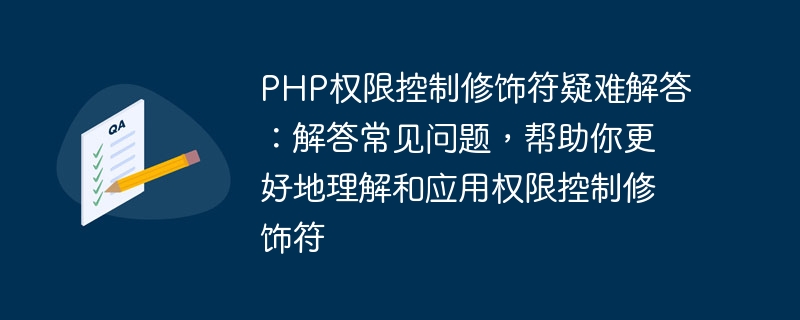

PHP permission control modifier troubleshooting:
In web applications, permission control is a very important part, and more and more applications need to Users are authenticated and authorized to protect sensitive data. In PHP, we can use permission control modifiers to control the visibility of classes and methods for better access control.
This article will discuss some common questions about PHP permission control modifiers, hoping to help readers better understand and apply permission control modifiers.
PHP permission control modifier refers to using public, protected, or private in a class to control the visibility of different types of member variables and member methods. These modifiers allow developers to control which member variables and member methods can and cannot be accessed externally.
The public modifier is the most common modifier, which can control the member variables and member methods in the class to be accessed from anywhere. Outside the class, you can use the object directly to access public member variables and methods.
The following is a sample code for the public modifier:
class MyClass { public $publicVar; public function myMethod() { echo "This is a public method."; } } $obj = new MyClass(); $obj->publicVar = "This is a public variable."; echo $obj->publicVar; // This is a public variable. $obj->myMethod(); // This is a public method.
In this example, the public modifier specifies that the member variable $publicVar and the member method myMethod can be accessed from anywhere.
The protected modifier can control the member variables and member methods in the class to be accessed only within the class and its subclasses. This modifier is very useful because it allows developers to control which member variables and member methods can be inherited and used by subclasses.
The following is a sample code for the protected modifier:
class MyClass { protected $protectedVar; protected function myMethod() { echo "This is a protected method."; } } class MySubClass extends MyClass { public function myMethod2() { $this->protectedVar = "This is a protected variable."; echo $this->protectedVar . "
"; // This is a protected variable. $this->myMethod(); // This is a protected method. } } $obj = new MySubClass(); $obj->myMethod2();
In this example, the protected modifier specifies that the member variable $protectedVar can only be used inside the MyClass class and its subclasses, and member methods myMethod can also be inherited and used by subclasses. In the subclass MySubClass, we can directly use the protectedVar and myMethod methods and successfully output the results.
The private modifier can control that member variables and member methods in a class can only be used inside the class. This modifier is used to hide the implementation details of the class and prevent external access to the private member variables and private methods of the class.
The following is a sample code for the private modifier:
class MyClass { private $privateVar; private function myMethod() { echo "This is a private method."; } public function myPublicMethod() { $this->privateVar = "This is a private variable."; echo $this->privateVar . "
"; // This is a private variable. $this->myMethod(); // This is a private method. } } $obj = new MyClass(); $obj->myPublicMethod();
In this example, the private member variable $privateVar and the private method myMethod can only be used inside the MyClass class. In the public method myPublicMethod, we can successfully access the private variables and private methods and output the results.
Since the private modifier is used to prevent external access to private member variables and private methods of the class, this access method is not recommended. However, we can use the magic methods __get and __call to access private variables and private methods.
The following is the sample code to access private variables and private methods:
class MyClass { private $privateVar; private function myMethod() { echo "This is a private method."; } public function __get($name) { return $this->$name; } public function __call($name, $args) { if (method_exists($this, $name)) { return call_user_func_array(array($this, $name), $args); } } } $obj = new MyClass(); $obj->privateVar = "This is a private variable."; echo $obj->privateVar; // This is a private variable. $obj->myMethod(); // This is a private method.
In this example, we define the magic methods __get and __call, and access private in these two methods Variables and private methods. Then we can successfully access the private member variables and private methods defined in the MyClass class.
Summary:
PHP permission control modifiers are an important tool for controlling the visibility of classes and methods, and are very useful in developing web applications. This article discusses some common issues about permission control modifiers and provides specific code examples to help readers better understand and apply permission control modifiers. If you are developing a web application and need to control access permissions, I hope this article will help you.
The above is the detailed content of Troubleshooting PHP permission control modifiers: Answers to frequently asked questions to help you better understand and apply permission control modifiers. For more information, please follow other related articles on the PHP Chinese website!




